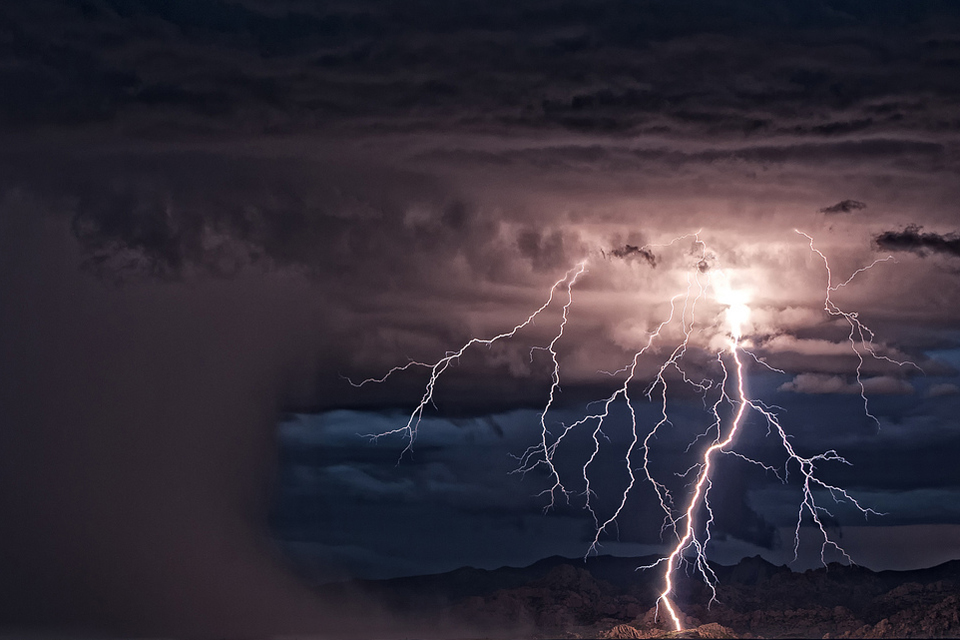
Thunder Bird: Arizona’s Lightning Captured by Stephen Maguire

The storm chasing started once on a trip from Arizona to Texas. When I was driving south of El Paso, I saw a big storm crossing the highway with bolts of lightning striking all around. That’s when I decided I wanted to chase storms and photograph them.
This past May I was chasing a supercell thunderstorm (revolving thunderstorm, quite rare and considered one of the most dangerous kinds, – Editor’s note). I had a great view of it as it was approaching me. On the other side of the road there was a power line. Well, I was shooting the storm when I felt something strange. It was like being shocked by an electric outlet at one’s home. I got down quickly and saw the lightning hit a power pole in less than a mile from me.
At moments like that you realize how dangerous it is. I had a couple of other close strikes, but nothing as memorable as that one. But after all I’m still doing it. I just love photographing storms, the beauty that comes with them, even though it only lasts for a few seconds.
For me this is just a normal life. If it hadn’t been for this hobby I would just sit around and get bored. I really enjoy getting out and seeing new things when I chase, and meeting some interesting people along the way. I didn’t do much before I started shooting storms – just worked and was trying to be a good father. Since I got fascinated by lightning I have grown to be much more patient. Also, I learnt to understand the weather, how it works, and to respect the powers of nature that produce these storms.
{“img”: “/wp-content/uploads/2014/12/light_01.jpg”, “alt”: “”},
{“img”: “/wp-content/uploads/2014/12/light_02.jpg”, “alt”: “”},
{“img”: “/wp-content/uploads/2014/12/light_03.jpg”, “alt”: “”},
{“img”: “/wp-content/uploads/2014/12/light_04.jpg”, “alt”: “”},
{“img”: “/wp-content/uploads/2014/12/light_05.jpg”, “alt”: “”}
The hardest part of shooting a storm is making sure you put yourself in a good position with it. It is dangerous to be in the path of the storm for too long. Usually you want to be on the side of he storm as it passes by.
I do a lot of looking at weather models a few days before a good chase day. I use an app called Radarscope on my iPad: it has all the NWS radars in the United States. On the day of the storm I start driving towards the place where it is most likely to hit and try to get in a good position for the shoot. There is a lot of waiting around for the conditions to become favorable for a storm to form. There is nothing 100 per cent predictable in nature.
I had to learn more about the weather, and the way the weather forecasting works. During the off season I scout new locations with good road structures – to be able to get out in case the storm changes direction and goes my way. An interesting landscape is also important for a good image. Sometimes you get lucky and it all comes together at the right time. Generally speaking, storm-chasing is all about being in the right place at the right time.
A lot depends on how active the lightning is around the storm. In Arizona a storm only lasts for 30-60 minutes. It’s very short lived, so if it isn’t doing much I just leave and go after another one.
I usually spend between 30 minutes to 2 hours driving to catch the storms in Arizona. My closest trip would probably be right outside of my town Sierra Vista: a round trip is about10-15 miles. My farthest trip would be to Texas: 900 miles and 14 hours on the road. Each year during the Monsoon I drive six to eight thousand miles around Arizona.
{“img”: “/wp-content/uploads/2014/12/light_06.jpg”, “alt”: “”},
{“img”: “/wp-content/uploads/2014/12/light_07.jpg”, “alt”: “”},
{“img”: “/wp-content/uploads/2014/12/light_08.jpg”, “alt”: “”},
{“img”: “/wp-content/uploads/2014/12/light_09.jpg”, “alt”: “”},
{“img”: “/wp-content/uploads/2014/12/light_10.jpg”, “alt”: “”},
{“img”: “/wp-content/uploads/2014/12/light_11.jpg”, “alt”: “”}
After a storm passes the sky gets so beautiful and the atmosphere seems much cleaner to photograph and look at. I have a sense of accomplishment after a storm has passed. I relax after a long day of chasing, trying to put myself in the right position, and actually getting that one shot. It makes the drive home very pleasant. That’s why my favorite part of the process is the actual shooting out in the field. I don’t care much about post-processing.
Of all storm varieties I love supercells best. They have a great structure and are usually fairly simple to keep up with because they move just in one direction – here, in Arizona, from the South-West to the North-East. Normal storms in Arizona are harder to keep track of – they tend to move all over the place. But both these types can be very photogenic to capture. However, I don’t chase hurricanes or typhoons. They are not so not so interesting and much more difficult to get a really great shot of. I like storms in open plains – storm cloud structures can be better observed there.
Right now my plans are to keep shooting and see what I can accomplish along the way. Every year brings new challenges and that’s what I look forward to more than anything else. I’m always looking for that next great shot.
{“img”: “/wp-content/uploads/2014/12/light_12.jpg”, “alt”: “”},
{“img”: “/wp-content/uploads/2014/12/light_13.jpg”, “alt”: “”},
{“img”: “/wp-content/uploads/2014/12/light_14.jpg”, “alt”: “”},
{“img”: “/wp-content/uploads/2014/12/light_15.jpg”, “alt”: “”},
{“img”: “/wp-content/uploads/2014/12/light_16.jpg”, “alt”: “”},
{“img”: “/wp-content/uploads/2014/12/light_17.jpg”, “alt”: “”}
New and best




